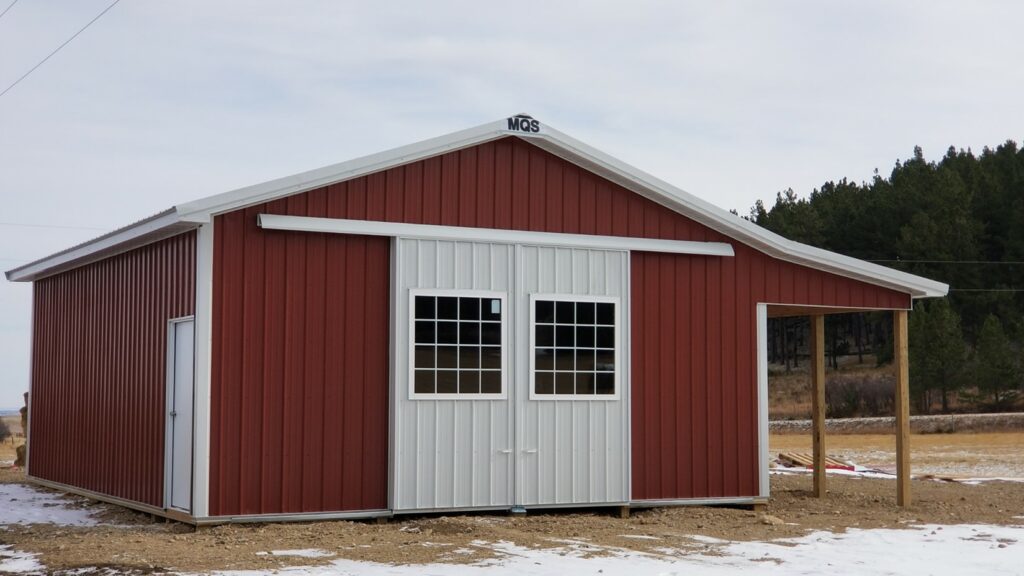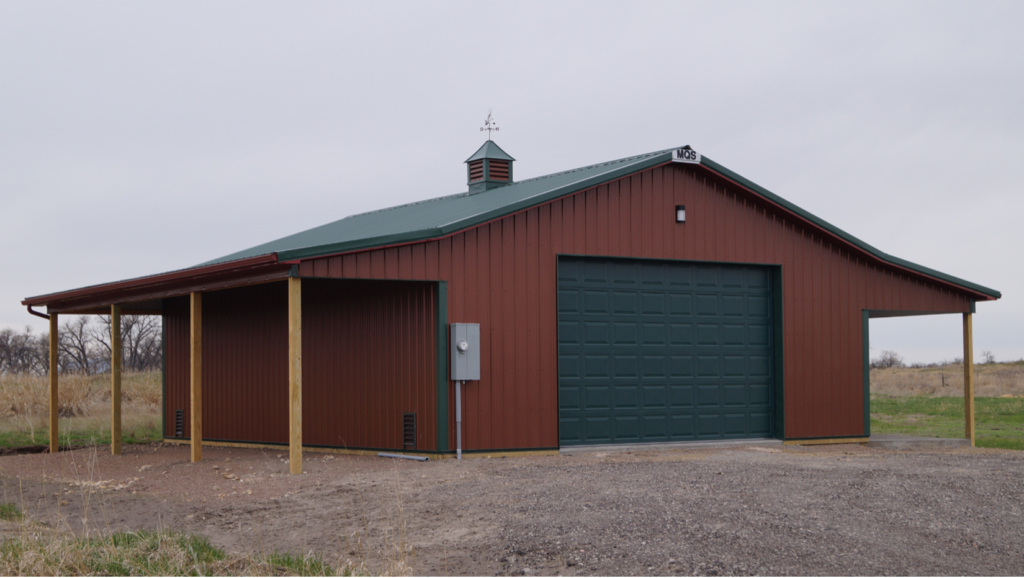When housing livestock and other animals, post-frame metal buildings in Montana offer a practical, durable option for farmers, agricultural business owners, and livestock managers. However, without the right features, these structures might not be a safe environment for the animals they house.
.
Tip #1 – Choose Sliding Doors Instead of Overhead Doors
Sliding doors are preferable in post-frame buildings for animal safety as they reduce the risk of injury compared to overhead doors. These doors glide smoothly along tracks, mitigating the chances of an abrupt closure that could startle or harm an animal. Furthermore, they require less overhead space, allowing for more consistent interior temperatures and minimizing drafts. Additionally, the easy operation of sliding doors ensures quick access during emergencies.
.
Tip #2 – Put Mats or Hay in Stalls Where Animals Are Held – Steel Buildings in Montana
Concrete and metal floors can be slick and cold, posing a danger to animals, especially when they lie down or get up. Placing mats or a generous layer of hay in the stalls offers insulation from cold floors and provides cushioning to reduce the risk of joint injuries. The softer surface offers better traction, reducing the likelihood of slips and falls. Mats also simplify the cleaning process, promoting a hygienic environment.
.
Tip #3 – Build Wide Aisles
Wide aisles allow for the safe movement of animals and humans within the building. They provide ample space for animals to pass without feeling confined, which can reduce stress and the chance of aggressive reactions. Additionally, wide aisles accommodate the use of machinery for cleaning or transport without putting animals at risk. Properly spaced aisles also facilitate evacuation during emergencies, ensuring animal and human welfare.
.

.
Tip #4 – Install Dutch Doors in Horse Stalls – Steel Buildings in Montana
Dutch doors, which are divided horizontally, offer excellent versatility for horse stalls. The top half can be opened to allow fresh air and social interaction while keeping the horses securely inside. The split design prevents horses from leaning and potentially damaging the door or injuring themselves. Furthermore, this type of door can be beneficial during feeding times by providing access without fully entering the stall.
.
Tip #5 – Store Hay in a Separate Structure
Storing hay in the same structure as animals presents a significant fire hazard, as hay is highly combustible. A separate building minimizes the risk of fire spreading to areas where animals are housed. It also reduces the exposure of hay to moisture, which can lead to mold growth and health risks to animals. Additionally, isolated storage helps deter pests that may be attracted to feed and livestock.
.
Tip #6 – Maximize Ventilation – Steel Buildings in Montana
Proper ventilation keeps the air in post-frame buildings fresh and removes excess moisture, which can lead to respiratory issues for animals. It rids the building of harmful gases like ammonia and methane that can accumulate in poorly ventilated spaces. Well-placed vents and windows help create a cross breeze, regulating the internal temperature. Farmers can ensure consistent air quality by installing ridge vents, eave vents, or ventilated skylight panels.
.
Tip #7 – Install Overhead Fans Designed for Agricultural Use
Overhead fans circulate air, which is crucial for maintaining a comfortable environment for the animals. Agricultural fans are built to withstand the dust and debris typical in barn settings. These fans improve air quality by moving stale air and reducing the build-up of airborne pathogens. They can also help to keep animals cool during warmer weather, reducing heat stress.
.
Are you looking for prefabricated barns in Montana?
Consider a post frame building instead!
.
Tip #8 – Add a Water Spigot and Water Trough – Steel Buildings in Montana
Access to clean, fresh water is vital for animal health. A conveniently placed water spigot and trough ensure that animals stay hydrated without needing labor-intensive water transportation. Water troughs should be cleaned regularly to prevent the spread of disease. In colder climates, installing a heated trough or a trough with a water heater will prevent freezing, guaranteeing constant water availability.
.
Tip #9 – Include Kick Panels on Walls
A kick panel is a durable liner that protects the lower part of the interior walls from damage from animal kicks or bumps. It absorbs the impact, preserving the structural integrity of the building. Kick panels also protect animals from injuring themselves on harder surfaces. Using high-density polyethylene (HDPE) materials ensures durability and ease of cleaning.
.

.
Tip #10 – Use Rounded Corners – Steel Buildings in Montana
Sharp corners can lead to injuries where animals might bump or rub against them. By rounding off corners within the building where possible, farmers can mitigate the risk of animal cuts and bruises. This is particularly relevant in areas where animals are likely to move rapidly or congregate.
.
Tip #11 – Implement Safe Electrical Wiring Practices
Electrical systems must be installed following strict safety standards to prevent accidents due to chewing or pecking. Wires should be encased in conduit and kept out of reach from curious animals. Regular inspections can detect potential hazards, like frayed wires or water leakage that may cause shorts. Safe electrical practices also include having proper grounding and circuit protection to handle the unique demands of agricultural environments.
.
Tip #12 – Design Smooth Surfaces for Easy Cleaning – Steel Buildings in Montana
Smooth surfaces are easier to clean and disinfect, reducing the hiding spots for bacteria and parasites. They enable farmers to maintain high standards of cleanliness with minimal effort. Seamless wall panels and slip-resistant yet smooth flooring are ideal choices. Prioritizing materials that can withstand heavy-duty cleaning agents without degradation helps in the long-term maintenance and health of the building.
.
Tip #13 – Reinforce Roofing against Potential Hazards
Roofing in steel buildings must be properly constructed and reinforced to protect against extreme weather conditions, which can present hazards for animals. Durable roofing materials that can withstand high winds, heavy snowfall, and other climate stresses are essential. Regular maintenance checks can help identify and rectify any vulnerabilities that could lead to leaks or collapses. Proper insulation also contributes to the animals’ comfort by keeping the building cool in the summer and warm in the winter.
.

.
Tip #14 – Securely Fasten All Fixtures – Steel Buildings in Montana
All items, such as lighting, fans, and racks, must be bolted and out of reach of animals. Regular checks can ensure fixtures remain securely in place over time. Similarly, hinges and latches on doors and gates should be robust and frequently maintained to prevent escape or injury.
.

.
MQS Barn – Metal Buildings in Montana
We have you covered if you want new post frame agricultural buildings in Montana. When you are ready to start, our team of custom post-frame builders can work with you to ensure you get the building you need.
MQS is a family-owned and operated company specializing in post-frame, steel-sided structures, and custom pole barns in Montana. The co-founder and co-owner of MQS Barn, Mark Stoltzfus, began his building career with his Amish Mennonite family and applies the same work ethic and expert craftsmanship on every project we do in Montana.
Call us today at 855-677-2276, or contact us online to receive a free quote on your next post frame building in Montana. We look forward to hearing from you soon!
